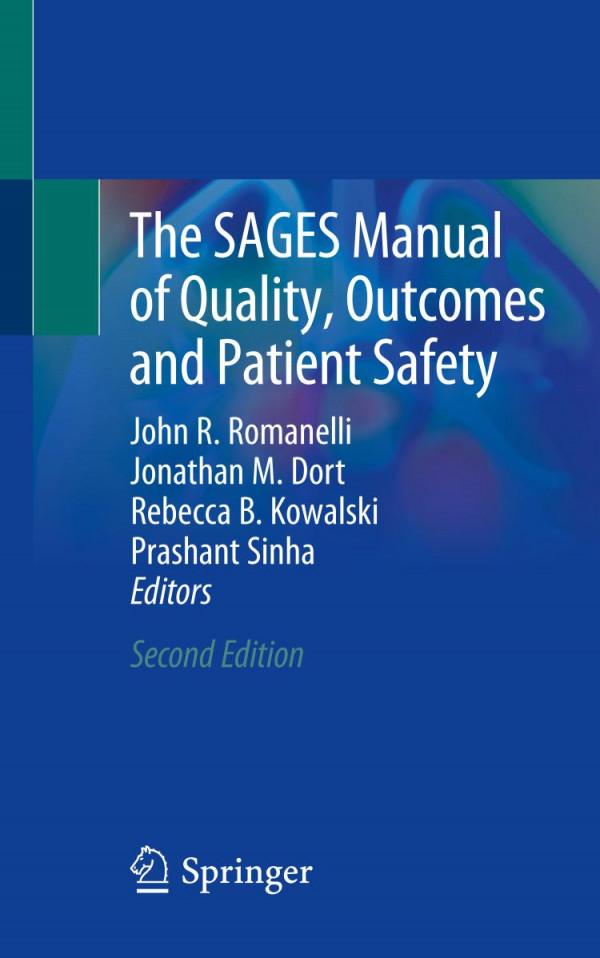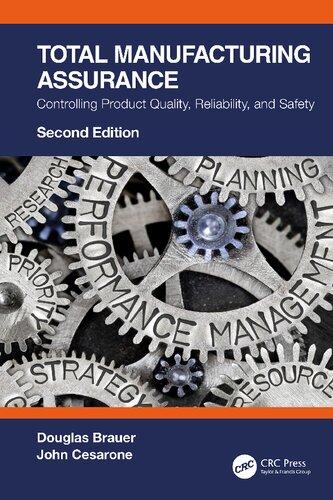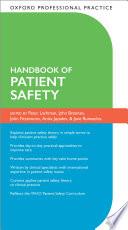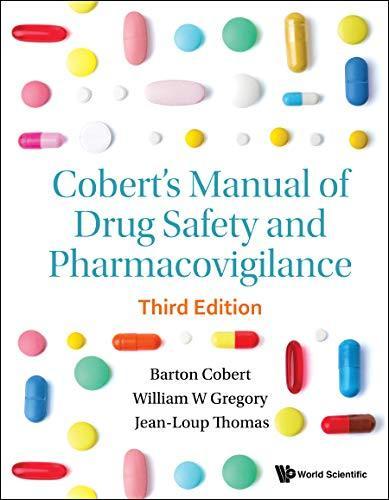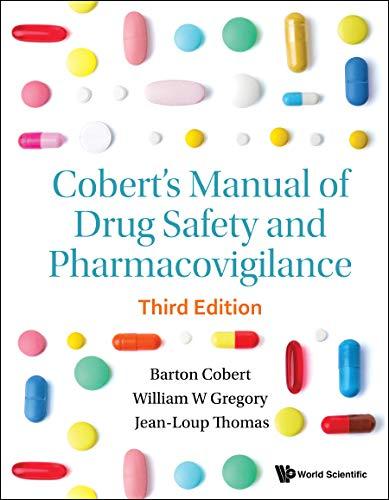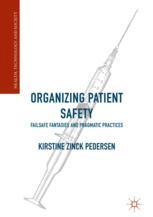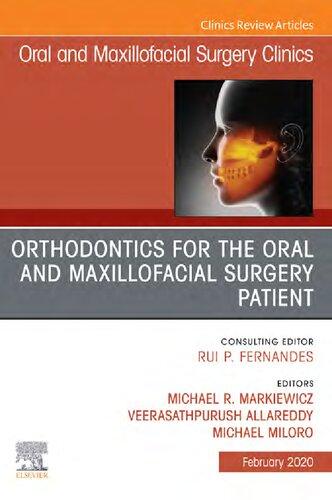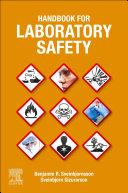Preface
Approximately a decade following the publication of the first edition of this manual, the world of surgery continues to dramatically change. The focus on the quality of care provided by surgeons, the safety of the patients we treat, and the clinical outcomes we see as a result of our care, by both the surgical community and the public, has never been stronger. SAGES remains committed to leading in these areas, and the work and expertise presented in this manual will hopefully serve as a comprehensive resource to all of our SAGES members, as well as to the broader surgical community. This manual covers a wide range of critical topics, from the language and basics of quality, outcomes, and patient safety to education, mentorship, new technologies, and different approaches to care. It is crucial for the care of their patients that surgeons understand all of the elements of how quality is measured, how care outcomes are reviewed, and what the best practices available to them are on how to provide that care. On behalf of the SAGES Quality, Outcomes, and Patient Safety Committee, I am indebted to the time and efforts of the committee members and authors who have helped to create this manual. I also wish to thank my co-editors, John Romanelli, Rebecca Kowalski, and Prashant Sinha, as well as to Erin Schwarz, who has provided all of the administrative support to this endeavor, for all of their hard work in producing this second edition. I hope that you find it to be informative, comprehensive, and useful.
Falls Church, VA, USA
Jonathan M. Dort, MD
1
3
4
B.
Anjali A. Gresens and Jacob A. Tatum
Samuel M. Miller and John M. Morton
5
6
Buğra Tugertimur and Bruce Ramshaw
Michael R. Keating and Benjamin E. Schneider
Brenda M. Zosa and Anne O. Lidor
Teresa L. LaMasters, Jamie P. Loggins, and Teresa Fraker
8
Ingrid S. Schmiederer and James N. Lau
10
12
14 Developing Patient-Centered Outcomes Metrics for Abdominal
Part III Surgical Safety
21 Quality, Safety, and the Electronic Health Record (EHR)
Eunice Y. Huang and Gretchen Purcell Jackson
22 Checklists, Surgical Timeout, Briefing, and Debriefing: Safety in the Operating Room .
Amelia T. Collings and Dimitrios Stefanidis
23 Creating Effective Communication and Teamwork for Patient Safety .
Pascal Fuchshuber and William Greif
Timothy Fokken and Sharon Bachman
25
Stacy M. Ranson and Jonathan M. Dort 26 Culture
Eileen R. Smith and Shaina R. Eckhouse
27 Learning New Operations and Introduction into Practice
Ugoeze J. Nwokedi, Lee Morris, and Nabil Tariq
Jaisa Olasky and Daniel B. Jones
30 Debriefing After Simulation
Brandon W. Smith and Neal E. Seymour
31 Using Simulation for Disclosure of Bad
Limaris Barrios
32 Teleproctoring in Surgery .
Julio Santiago Perez and Shawn Tsuda
33 Training for Quality: Fundamentals Program . . .
Sofa Valanci and Gerald M. Fried
34 Training to Proficiency .
Madhuri B. Nagaraj and Daniel J. Scott
35 The Critical View of Safety: Creating Procedural Safety Benchmarks .
William C. Sherrill III and L. Michael Brunt
36 Mentorship and Quality in Surgery .
Dina Tabello and Jonathan M. Dort
Part V Threats to Surgical Quality, Outcomes, and Safety
37 Disparities in Healthcare: The Effect on Surgical Quality .
Valeria S. M. Valbuena and Dana A. Telem
38 Surgeon Wellness: Scope of the Problem and Strategies to Avoid Burnout
John R. Romanelli
39 The Disruptive Surgeon .
M. Shane Dawson and Rebecca B. Kowalski
40 The Surgeon as Collateral Damage: The Second Victim Phenomenon.
Rebecca Gates and Charles Paget
41 The Surgeon in Decline: Can We Assess and Train a Surgeon as Their Skills Deteriorate?
Arthur Rawlings
42 Fatigue in Surgery: Managing an Unrealistic Work Burden
V. Prasad Poola, Adam Reid, and John D. Mellinger
43 Training New Surgeons: Maintaining Quality in the Era of Work Hour Regulations .
Ingrid S. Schmiederer and James R. Korndorffer Jr
44 Maintaining Surgical Quality in the Setting of a Crisis . .
John R. Romanelli
45 Ergonomic Considerations for Surgeon Physical Wellness . .
Marinda Scrushy and Diana L. Diesen
Part VI Surgical Controversies That Impact Quality
46 Hernia Repair: Robot or No Robot? .
Matthew Madion and Rana M. Higgins
47 The Consistent Operating Room Team . .
Leena Khaitan and Joseph Youssef
889
907
48 Prevention of Common Bile Duct Injury: What Are we as Surgeons Doing to Prevent Injury . . . . . . 923
Nabajit Choudhury, Manoj Kumar Choudhury, and Rebecca B. Kowalski
49 OR Attire: Does it Impact Quality? . .
Yasmin Essaji, Kelly Mahuron, and Adnan Alseidi
50 Learning When Not to Operate: From Patient Selection to Withdraw of Care
Carolyn Judge, Kim Gerling, and Tiffany C. Cox
51 The Changing Paradigm in Acute Care Surgery: Who Is the Best to Offer the Care? .
Freeman Condon and Robert Lim
52 Super-subspecialization of General Surgery: Is This Better for Patients? . .
Joseph A. Sujka and Christopher G. DuCoin
933
955
. 971
985
53 What Is the Connection Between Physician Relationships with Industry and Patient Care? . . . . . 993
Caroline E. Reinke, Peter M. Denk, Erin Schwarz, and Phillip P. Shadduck
1005
Contributors
Gina Adrales Johns Hopkins University School of Medicine, Baltimore, MD, USA
Thomas A. Aloia University of Texas MD Anderson Cancer Center, Houston, TX, USA
Adnan Alseidi Department of Surgery, University of California San Francisco, San Francisco, CA, USA
Sharon Bachman Department of Surgery, Inova Fairfax Medical Campus, Falls Church, VA, USA
Limaris Barrios Dr. Kiran C. Patel College of Allopathic Medicine (NSU MD), Nova Southeastern University in Florida, Fort Lauderdale, FL, USA
Marylise Boutros Division of Colon and Rectal Surgery, Sir Mortimer B. Davis Jewish General Hospital, Montreal, QC, Canada
L. Michael Brunt Department of Surgery and Section of Minimally Invasive Surgery, Washington University School of Medicine, St. Louis, MO, USA
Stephanie Calcasola Hartford HealthCare, Hartford, CT, USA
Manoj Kumar Choudhury Senior Consultant, GI and MIS, Nemcare Superspecialty Hospital, Assam, India
Nabajit Choudhury The University of Tennessee Health Science Center, Memphis, TN, USA
Freeman Condon Tripler Army Medical Center, Honolulu, HI, USA
Tiffany C. Cox Department of Surgery, Uniformed Services University of Health Sciences & Walter Reed National Military Medical Center, Bethesda, MD, USA
M. Shane Dawson Northwell Health at Lenox Hill Hospital, New York, NY, USA
Peter M. Denk GI Surgical Specialists, Fort Myers, FL, USA
Diana L. Diesen Department of Surgery, University of Texas Southwestern Medical Center, Dallas, TX, USA
Justin B. Dimick Department of Surgery, University of Michigan, Ann Arbor, MI, USA
Jonathan M. Dort Department of Surgery, Inova Fairfax Medical Campus, Falls Church, VA, USA
Christopher G. DuCoin Department of Surgery, University of South Florida Morsani College of Medicine, Tampa, FL, USA
Shaina R. Eckhouse Section of Minimally Invasive Surgery, Department of Surgery, Washington University School of Medicine, Saint Louis, MO, USA
Yasmin Essaji Division of HPB Surgery, Virginia Mason Medical Center, Seattle, WA, USA
Liane S. Feldman Department of Surgery, McGill University, Montreal, QC, Canada
Julio F. Fiore Department of Surgery, McGill University, Montreal, QC, Canada
Benjamin J. Flink Stony Brook University Department of Surgery, Division of Bariatric, Foregut, and Advanced Gastrointestinal Surgery, Stony Brook, NY, USA
Timothy Fokken Department of Surgery, Inova Fairfax Medical Campus, Falls Church, VA, USA Contributors
Teresa Fraker Metabolic and Bariatric Surgery Accreditation and Quality Improvement Program (MBSAQIP), Division of Research and Optimal Patient Care (DROPC), American College of Surgeons (ACS), Chicago, IL, USA
Gerald M. Fried Professor of Surgery and Associate Dean for Education Technology and Innovation, Montreal, QC, Canada
Faculty of Medicine and Health Sciences, McGill University, Montreal, QC, Canada
Director, Steinberg Centre for Simulation and Interactive Learning, Faculty of Medicine and Health Sciences, McGill University, Montreal, QC, Canada
Pascal Fuchshuber Sutter East Bay Medical Group, UCSFEast Bay, Oakland, CA, USA
Rebecca Gates Virginia Tech Carilion School of Medicine and Carilion Clinic, Roanoke, VA, USA
Kim Gerling Department of Surgery, Uniformed Services University of Health Sciences & Walter Reed National Military Medical Center, Bethesda, MD, USA
Michael Ghio Tulane University School of Medicine & Tulane Medical Center, New Orleans, LA, USA
William Greif The Permanente Medical Group, Kaiser Walnut Creek Medical Center, Walnut Creek, CA, USA
Anjali A. Gresens Bariatric Surgery, Sentara Medical Group, Norfolk, VA, USA
Department of Surgery, Eastern Virginia Medical School, Norfolk, VA, USA
Rana M. Higgins Medical College of Wisconsin, Milwaukee, WI, USA
Ryan Howard Department of Surgery, University of Michigan, Ann Arbor, MI, USA
Eunice Y. Huang Departments of General and Thoracic Surgery, Monroe Carell Jr. Children’s Hospital at Vanderbilt, Nashville, TN, USA
Contributors
Gretchen Purcell Jackson Departments of General and Thoracic Surgery, Monroe Carell Jr. Children’s Hospital at Vanderbilt, Nashville, TN, USA
Intuitive Surgical, Sunnyvale, CA, USA
Daniel B. Jones Department of Surgery, Rutgers New Jersey Medical School, Newark, NJ, USA
Carolyn Judge Department of Surgery, Uniformed Services University of Health Sciences & Walter Reed National Military Medical Center, Bethesda, MD, USA
Michael R. Keating University of Texas Southwestern, Dallas, TX, USA
Deborah S. Keller Division of Colorectal Surgery, Department of Surgery, University of California at Davis, Sacramento, CA, USA
Leena Khaitan University Hospitals, Department of Surgery, Cleveland, OH, USA
James R. Korndorffer Jr Department of Surgery, Stanford University School of Medicine, Stanford, CA, USA
Anai N. Kothari Department of Surgery, Division of Surgical Oncology, Medical College of Wisconsin, Milwaukee, WI, USA
Rebecca B. Kowalski Northwell Health at Lenox Hill Hospital, New York, NY, USA
Danuel Laan Tulane University School of Medicine & Tulane Medical Center, New Orleans, LA, USA
Kathleen Lak Bariatric and Minimally Invasive Gastrointestinal Surgery, Medical College of Wisconsin, Milwaukee, WI, USA
Teresa L. LaMasters Iowa Methodist Medical Center Unity Point Clinic, University of Iowa, Des Moines, IA, USA
Contributors
James N. Lau Loyola University Medical Center, Department of Surgery, Maywood, IL, USA
Shauna Levy Tulane University School of Medicine & Tulane Medical Center, New Orleans, LA, USA
Anne O. Lidor Department of Surgery, Johns Hopkins University SOM, Baltimore, MD, USA
Cara A. Liebert Department of Surgery, Stanford University School of Medicine, VA Palo Alto Health Care System, Palo Alto, CA, USA
Robert Lim University of Oklahoma School of Medicine Tulsa, Tulsa, OK, USA
Jamie P. Loggins Mission Weight Management Center, Asheville, NC, USA
Matthew Madion Medical College of Wisconsin, Milwaukee, WI, USA
Kelly Mahuron Department of Surgery, University of California San Francisco, San Francisco, CA, USA
John D. Mellinger Southern Illinois University School of Medicine, Department of Surgery, Springfield, IL, USA
Samuel M. Miller Department of Surgery, Yale School of Medicine, New Haven, CT, USA
Jeongyoon Moon Division of Colon and Rectal Surgery, Sir Mortimer B. Davis Jewish General Hospital, Montreal, QC, Canada
Lee Morris Department of Surgery, The Houston Methodist Hospital, Houston, TX, USA
John M. Morton Department of Surgery, Yale School of Medicine, New Haven, CT, USA
Madhuri B. Nagaraj University of Texas Southwestern, Department of Surgery, Dallas, TX, USA
Brian J. Nasca Northwestern University Feinberg School of Medicine, Chicago, IL, USA
Ugoeze J. Nwokedi Department of Surgery, The Houston Methodist Hospital, Houston, TX, USA
Jaisa Olasky Mount Auburn Hospital, Harvard Medical School, Boston, MA, USA
Rocco Orlando III Hartford HealthCare, Hartford, CT, USA
University of Connecticut School of Medicine, Hartford, CT, USA
Charles Paget Virginia Tech Carilion School of Medicine and Carilion Clinic, Roanoke, VA, USA
John T. Paige Department of Surgery, MedicineLouisiana State University (LSU) Health New Orleans School of Medicine, New Orleans, LA, USA
Julio Santiago Perez Valley Health System General Surgery Department, Las Vegas, NV, USA
V. Prasad Poola Southern Illinois University School of Medicine, Department of Surgery, Springfield, IL, USA
Aurora D. Pryor Stony Brook University Department of Surgery, Division of Bariatric, Foregut, and Advanced Gastrointestinal Surgery, Stony Brook, NY, USA
Fateme Rajabiyazdi Department of Systems and Computer Engineering, Carleton University, Ottawa, ON, Canada
Bruce Ramshaw Managing Partner, CQInsights PBC, Knoxville, TN, USA
Stacy M. Ranson Inova Fairfax Medical Campus, Falls Church, VA, USA
Arthur Rawlings General Surgery, University of Missouri, One Hospital Drive, Columbia, MO, USA
Swathi Reddy Johns Hopkins University School of Medicine, Baltimore, MD, USA
Contributors
Adam Reid Southern Illinois University School of Medicine, Department of Surgery, Springfield, IL, USA
Caroline E. Reinke Department of Surgery, Atrium Health, Charlotte, NC, USA
Amelia T. Collings Department of Surgery, Indiana University School of Medicine, Indianapolis, IN, USA
John R. Romanelli Department of Surgery, University of Massachusetts Chan Medical School - Baystate Medical Center, Springfield, MA, USA
Ingrid S. Schmiederer Department of Surgery, Stanford University School of Medicine, Stanford, CA, USA
New York Presbyterian-Queens, Department of Surgery, Flushing, NY, USA
Benjamin E. Schneider University of Texas Southwestern, Dallas, TX, USA
Erin Schwarz SAGES, Los Angeles, CA, USA
Daniel J. Scott University of Texas Southwestern, Department of Surgery and Simulation Center, Dallas, TX, USA
Marinda Scrushy Department of Surgery, University of Texas Southwestern Medical Center, Dallas, TX, USA
Neal E. Seymour Baystate Medical Center, Department of Surgery, Springfield, MA, USA
Phillip P. Shadduck Duke University, Durham, NC, USA
William C. Sherrill III Department of Surgery and Section of Minimally Invasive Surgery, Washington University School of Medicine, St. Louis, MO, USA
Prashant Sinha Department of Surgery, NYU Langone Medical Center, Brooklyn, NY, USA
Brandon W. Smith Baystate Medical Center, Department of Surgery, Springfield, MA, USA
Contributors
Eileen R. Smith Section of Minimally Invasive Surgery, Department of Surgery, Washington University School of Medicine, Saint Louis, MO, USA
Dimitrios Stefanidis Department of Surgery, Indiana University School of Medicine, Indianapolis, IN, USA
Jonah J. Stulberg The University of Texas Health Science Center at Houston, Houston, TX, USA
Joseph A. Sujka Department of Surgery, University of South Florida Morsani College of Medicine, Tampa, FL, USA
Dina Tabello Inova Fairfax Medical Campus, Falls Church, VA, USA
Nabil Tariq Department of Surgery, The Houston Methodist Hospital, Houston, TX, USA
Jacob A. Tatum Department of Surgery, Eastern Virginia Medical School, Norfolk, VA, USA
Dana A. Telem National Clinician Scholars Program, University of Michigan, Ann Arbor, MI, USA
Shawn Tsuda Valley Health System General Surgery Department, Las Vegas, NV, USA
Bu ğ ra Tugertimur General Surgery Resident, PGY 5, Department of Surgery, Lenox Hill Hospital, Northwell Health, New York City, NY, USA
Sofia Valanci Doctoral student in Experimental Surgery, Education Concentration, McGill University, Montreal, QC, Canada
Valeria S. M. Valbuena University of Michigan, Department of Surgery, Ann Arbor, MI, USA
Sherry M. Wren Department of Surgery, Center for Innovation and Global Health, Stanford University School of Medicine, VA Palo Alto Health Care System, Palo Alto, CA, USA
Contributors
Tonia M. Young-Fadok Division of Colon and Rectal Surgery, Mayo Clinic, Phoenix, AZ, USA
Joseph Youssef University Hospitals, Department of Surgery, Cleveland, OH, USA
Brenda M. Zosa Department of Surgery, Johns Hopkins University SOM, Baltimore, MD, USA
Chapter 1 Defining Quality in Surgery
Ryan Howard and Justin B. Dimick
Introduction
With recognition of wide variations in surgical performance, demand for information on surgical quality is at an all-time high. Patients and families are turning to their physicians, hospital report cards, and the Internet to identify the safest hospitals for surgery [1]. Payers and purchasers are using efforts to reward high quality (e.g., pay for performance) or steer patients toward the highest quality providers (e.g., selective referral) [2]. In addition to responding to these external demands, providers are becoming more involved in leveraging their own quality measurement platforms to improve surgical care, such as the National Surgical Quality Improvement Program (NSQIP) [3]. Finally, professional organizations are now accrediting hospitals based on their ability to meet certain metrics believed to be associated with better outcomes [4].
Despite the need for good measures of quality in surgery, there is very little agreement about how to best assess surgi-
R. Howard · J. B. Dimick (*)
Department of Surgery, University of Michigan, Ann Arbor, MI, USA
e-mail: jdimick@umich.edu
© The Author(s), under exclusive license to Springer Nature Switzerland AG 2022
J. R. Romanelli et al. (eds.), The SAGES Manual of Quality, Outcomes and Patient Safety, https://doi.org/10.1007/978-3-030-94610-4_1
3
R. Howard and J. B. Dimick
cal performance. According to the widely used Donabedian paradigm, quality can be measured using various aspects of structure, process, or outcome [5]. In addition, many widely recognized quality measurement efforts, such as those by the Leapfrog group, use composite, or “global,” measures of quality, which combine one or more elements of structure, process, and outcome [6]. In this chapter, we consider the advantages and disadvantages of each type of quality measure. We close by making recommendations for choosing among these different approaches.
Structure
The structure of surgical care refers to measurable attributes of a hospital (e.g., size and volume) or its providers (e.g., specialty training and years in practice) (Table 1.1). Measures of structure are extensively used in the measurement of surgical quality, owing to their widespread availability. The American College of Surgeons (ACS) and the American Society of Metabolic and Bariatric Surgeons (ASMBS) accredit hospitals for bariatric surgery based largely on measures of structure, including hospital volume, surgeon volume, and other structural elements necessary for providing multidisciplinary care for the morbidly obese [4].
Structural elements have several key strengths as quality measures. First, they are relatively easy to ascertain. Often, structural elements such as volume can be obtained from readily available administrative data. Second, many structural measures are strong predictors of hospital and surgeon outcomes. The most well-known example of this relationship was described by Birkmeyer et al., who observed a fivefold difference in mortality between low- and high-volume hospitals for high-risk surgical procedures [7]. This same relationship holds true for individual surgeon volume as well [8]. Since the early 2000s, the volume-outcome relationship has been demonstrated for dozens of operations [9].
Table 1.1 Approaches to measuring the quality of care for aortic surgery with advantages and disadvantages of each approach
Type of
measure
Example
Structure Hospital or surgeon volume
Process Prophylactic antibiotics given on time
Adherence to venous thromboembolism prevention guidelines
Outcomes
Anastomotic leak rates with bariatric surgery
Wound infection with ventral hernia repair
Composite Leapfrog group’s “Survival Predictor”
Not granular enough to identify specific clinical areas that need improvement Chapter 1. Defining Quality
Advantages Disadvantages
Inexpensive and readily available
Good proxy for outcomes
Actionable as targets for improvement
Less influenced by patient risk and random errors
Not actionable for quality improvement
Not good for discriminating among individual providers
Known processes relate to unimportant or rare surgical outcomes
Very few “high leverage” processes of care are known
Seen as the bottom line of patient care
Enjoy good “buy-in” from surgeons
Addresses problems with small sample size
Makes sense of multiple conflicting measures
Sample sizes often too small at individual hospitals
Need for detailed data for risk adjustment
R. Howard and J. B. Dimick
However, there are certain limitations of using structural quality measures. Most importantly, they are proxies for quality rather than direct measures. As a result, they only hold true on average. For example, while high-volume surgeons are better than low-volume surgeons on average, there are likely to be some high-volume surgeons with bad outcomes and low-volume surgeons with good outcomes [5]. What’s more, structural measures are not meaningfully actionable for quality improvement. Hospitals cannot easily change their operative volume, although regionalization of high-risk care may offer a solution to centralize care at more specialized centers and leverage the volume-outcome relationship.
In recent years, structural measures of care have also been found to be lacking when implemented as real-world quality metrics. For example, after certain high-risk cancer operations, there was no mortality difference in hospitals that met the Leapfrog group’s minimum volume standards and those that did not [10]. Similarly, even among hospitals designated as bariatric centers of excellence based on volume standards, there is still a 17-fold difference in rates of serious complications [11].
Process
Processes of care are the steps and details of a patient’s care that can lead to good (or bad) outcomes. Although processes of care can represent details of care in the preoperative, intraoperative, and postoperative phases, the most familiar process measures focus on details in the immediate preoperative phase of patient care. For example, the Center for Medicare and Medicaid Services (CMS) Surgical Care Improvement Project (SCIP) measures utilization of preoperative antibiotic and venous thromboembolism prophylaxes. Along these lines, one of the most familiar approaches to improving the process of care in surgery is the use of a presurgical checklist, which verifies that a number of best practices (confirming patient name, procedure laterality, administration of antibiotics, etc.) have been performed [12]. This has now become standard practice in the United States.
Process measures have several strengths as quality measures (Table 1.1). First, processes of care are extremely actionable in quality improvement. When hospitals and surgeon are “low outliers” for process compliance (e.g., patients not getting timely antibiotic prophylaxis), they know exactly where to target improvement. Second, in contrast to risk-adjusted outcomes measurement, processes of care do not need to be adjusted for differences in patient risk, which limits the need for data collection from the medical chart and saves valuable time and effort.
However, using processes of care has several significant limitations in surgery. First, most existing process measures are not strongly related to important outcomes. For example, the SCIP measures, which are by far the most widely used process measure in surgery, are not related to surgical mortality, infections, or thromboembolism [13]. Similarly, after implementing the preoperative checklist in 101 hospitals in Ontario, Canada, there was no measurable change in postoperative complications or mortality [14]. The lack of a relationship between process improvement and surgical mortality can be explained by the fact that the complications they aim to prevent are secondary (e.g., superficial wound infection) or extremely rare (e.g., pulmonary embolism). However, there is also a very weak relationship between process measures and the outcome they are supposed to prevent (e.g., timely administration of prophylactic antibiotics and wound infection) [15]. This finding is more difficult to explain. It is possible that there are simply multiple other processes (many unmeasured or unmeasurable) that contribute to good surgical outcomes. As a result, it is likely that adherence to process best practices is necessary but not sufficient for good surgical outcomes.
Outcome
Outcomes represent the end results of care. In surgery, the most commonly evaluated outcomes are mortality, serious complications, and hospital readmissions. For example, the
R. Howard and J. B. Dimick
NSQIP, the largest clinical registry focusing on surgery, reports risk-adjusted morbidity and mortality rates to participating hospitals [3]. While morbidity and mortality have long been the “gold standard” in surgery, patient-reported outcomes such as functional status and quality of life are also critically important.
Direct outcome measures have several strengths (Table 1.1). First, everyone agrees that outcomes are important. Measuring the end results of care makes intuitive sense to surgeons and other stakeholders. For example, the NSQIP has been enthusiastically championed by surgeons and other clinical leaders [16]. Second, outcomes feedback alone may improve quality. This so-called Hawthorne effect is seen whenever outcomes are measured and reported back to providers. For example, the NSQIP in the Veterans Affairs (VA) hospitals and private sector has documented improvements over time that cannot be attributed to any specific efforts to improve outcomes [17].
However, outcome measures have key limitations. First, when the event rate is low (numerator) or the number of cases is small (denominator), outcomes cannot be reliably measured. Small sample size and low event rates conspire to limit the statistical power of hospital outcomes comparisons. For most operations, surgical mortality is too rare to be used as a reliable quality measure [18]. For example, a study examining seven operations for which mortality was advocated as a quality measure by the Agency for Healthcare Research and Quality (AHRQ) found that only one of the seven operations – coronary artery bypass surgery – had high enough caseloads to reliably measure quality with surgical mortality [19].
Accurately measuring and comparing outcomes as a quality improvement instrument is also confounded by many factors. Surgical outcomes are influenced not only by quality of care but also by random variation, sample size, and case mix. Whereas structure and process measure are fixed elements of care, outcomes require additional risk and reliability adjust-
